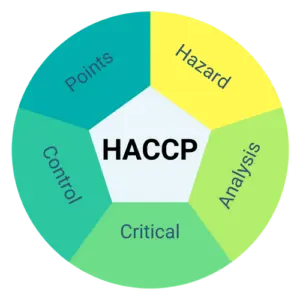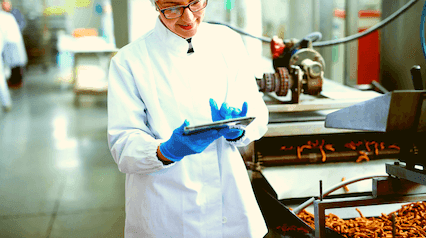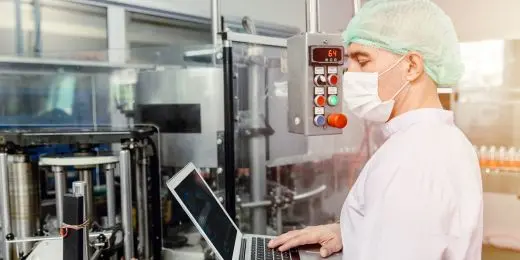What is a HACCP System?
A Hazard Analysis Critical Control Point or HACCP system aims to mitigate food safety risks and hazards. HACCP identifies possible dangers to public health and empowers a proactive approach to food safety by setting critical control points. The HACCP system identifies and controls the three following potential food safety hazards: biological, chemical, and physical.
What is a HACCP Plan?
A HACCP Plan is an operating plan for controlling and managing hazards in the food manufacturing industry. Using a HACCP plan ensures food products are safe and of high quality. It helps protect consumers from foodborne illnesses and reduce instances of product recalls, helping companies save money and protecting them from hefty fines and laborious lawsuits. It can also be used with other frameworks and standards such as ISO 22000 and IFS Food Standard.

7 Principles of an Effective HACCP Plan
Developing an effective HACCP plan requires guidance. Below are 7 principles that serves as a HACCP guideline:
Principle #1: Conduct A Hazard Analysis
An effective hazard analysis involves listing down the steps in the production process and identifying the hazards associated with each task performed. Afterwards, the HACCP team should assess the severity, significance, and frequency of the risk and set preventive measures. Browse this page to learn how to perform a systematic risk assessment.
Principle #2: Determine the CCPs
A Critical Control Point or CCP is a step in the production process where you have the opportunity to prevent, mitigate, or completely eliminate a food safety hazard (e.g. receiving products, food preparation and handling, cooking, reheating, transportation, etc.).
Principle #3: Establish Critical Limits of CCPs
A critical limit is the minimum/ maximum value for the control measure at a CCP to prevent, eliminate, or reduce the occurence of a hazard. It separates safe and acceptable products from the unsafe and unacceptable. Examples include measuring time, temperature, pH levels, water activity, weight, and other measures based on regulatory standards.
Principle #4: Setup a Monitoring System
Monitoring CCPs on a regular basis helps keep track of the operation to determine if there’s a deviation from the CCP or a loss of control. Monitored CCPs can provide data for proper documentation to help establish corrective actions.
Principle #5: Establish Corrective Actions
Corrective actions must be in place when preventive measures are not sufficient to meet the goals of the plan. Corrective actions are followed when there is a deviation from a critical limit. HACCP team should identify the problem and cause of non-conformance, and the disposition of the hazardous product. Make sure that corrective actions are recorded and properly documented.
Principle #6: Verify the HACCP Plan
Verifying a HACCP plan should not be limited to just monitoring of the operation, you must validate if the HACCP system is operating according to the intended course of action. Examples of verification activities include product testing, consulting experts, in-plant observations, instrument calibration, and log reviews.
Principle #7: Establish Documentation
A detailed HACCP plan record serves as strong evidence that the manufactured food is safe and has undergone critical procedures to cover all possible risks. All records should contain complete information of the 5 prerequisites and 7 principles.
Create your own HACCP Plan Template
Build from scratch or choose from our collection of free, ready-to-download, and customizable templates.
Browse HACCP Plan TemplatesA HACCP Plan is most effective by performing each step thoroughly and rigorously. The HACCP team must be committed to regularly validate the process and identify what might go wrong. To support the HACCP plan, a good manufacturing practice (GMP) can be established to ensure all manufacturing procedures are safe and comply with manufacturing standards.
5 Steps to Developing a Good HACCP Plan
When preparing and processing food, some natural hazards could be present in the form of insects or filth. Other hazards could be unintentional like the presence of hair or mislabeling of ingredients. Higher risk hazards can include intentional adulteration or contamination of products by not adhering to regulatory food standards.
Food production safety should be the topmost priority for food manufacturers. Here are the 5 prerequisites to developing a good HACCP plan.
- Identify who’s involved – Assemble a multidisciplinary HACCP team which represents individuals from all areas of the facility. (e.g. QA, R&D, Sanitation, Maintenance, Shipping and Receiving, Production and Purchasing, etc)
- Describe the product and its purpose – Have your HACCP team describe the food and its intended use. Define processing methods and how it is distributed.
- Know your consumers – Determine the target consumers, this could be the general public or a particular demographic with specific needs. (e.g. infants, pregnant women, the elderly, etc.).
- Create a flow diagram – To further understand the product and its production process, develop a flow diagram to clearly outline the steps of the whole plan.
- Verify your diagram – Evaluate the accuracy and completeness of the flow diagram by conducting inspections during actual work operations.
Improve your EHS Management
Cultivate a safe working environment and streamline compliance with our EHS solutions.
Explore nowWhat is a Critical Control Point (CCP)?
A CCP is a pause point within a production process a business has the opportunity to prevent, mitigate, or eliminate a food safety hazard. It is accompanied by a critical limit which is a set boundary where measurements must stay within to minimize food safety hazards. Any deviations from the critical limit must be accompanied by predefined corrective actions to fix the issue.
CCP monitoring involves scheduled measurements and record keeping of CCPs to ensure they are within their critical limits. Here is a framework including examples and record keeping tips on how to perform effective CCP monitoring:
| CCP Monitoring Framework | |||
| Item | Description | Example | Record Keeping Tips |
| CCP Step | A key step in the production process which is at risk of food safety hazards.
This step should be able to be paused and monitored. |
Reprocessing of poultry involving vacuuming and trimming | Your HACCP team should identify and prioritize this as part of their hazard analysis and document it in a HACCP plan template |
| Critical Limit | Set boundaries where measurements must stay within to minimize food safety hazards | No visible fecal contamination and 20-50ppm chlorine | Include detailed staff instructions in your record keeping tool on how to perform measurements and check against critical limits |
| Monitoring Procedure | Establishes the frequency of monitoring, by whom, what to observe, and how to observe. | Line supervisor will conduct hourly random sampling to check for visible fecal matter.
Line supervisor to check chlorine every 2 hours. |
HACCP routine monitoring records should include date, time, photo evidence, staff doing the monitoring, and observation details. |
| Corrective Actions | Details the steps to take if critical limits are not met. | Reprocess or condemn.
Adjust and recheck chlorinator. |
Corrective/ Deviation Action Log |
| HACCP Verifications | CCP monitoring tools and records are checked. | Daily check of records.
Chemical testing once a day. |
Ideally done and recorded by a designated staff who did not conduct the CCP monitoring. |
Using a corrective action log, details of the deviation from critical limits and the corresponding corrective action done should be recorded every time they happen. It is important to capture the exact date and time as well as the name of the staff who carried out the action.
HACCP Verification
Verification is a crucial principle of HACCP that helps confirm if a HACCP Plan is being followed and if the procedures implemented are indeed effective in controlling food safety hazards. Recordkeeping verification helps review corrective actions taken and ensures that they are done properly.
Trends in the frequency and types of deviations from critical limits can be observed through verification. If done routinely just like in monitoring CCPs, verification can help in the consistent implementation and continuous improvement of a HACCP system.
See how Marley Spoon, a trusted food delivery business in Australia, uses technology to mitigate food safety risks and ensure each step of the production aligns with their HACCP plan.
FAQs About HACCP Plan
HACCP, simply explained, is a systematic approach to identifying potential hazards in food production processes, determining where those hazards can be prevented or eliminated, and continuously monitoring them to make sure that control points stay in place. By implementing this system, food producers can reduce the risk of foodborne illness and ensure that their products are safe for consumption.
A HACCP plan is developed and written not just by an individual but as a collaborative effort of key stakeholders and key company employees or the HACCP team. The HACCP team typically consists of individuals with in-depth knowledge and expertise in the specific food production process being analyzed, such as food scientists, microbiologists, engineers, and quality assurance professionals.
A HACCP plan should be checked and validated regularly to ensure that it remains effective in preventing hazards and producing safe food. Although there’s no set interval for each review, HACCP plans should ideally be evaluated and updated whenever there’s newly-introduced assets (e.g., equipment), ingredient, materials, or any form of change in the process of food production.
No, the FDA does not formally approve HACCP plans developed by companies. HACCP plans, however, are a requirement for some of the inspections performed by the FDA like the assessment for Food Safety Modernization Act (FSMA). The FDA also requires food producers to have a HACCP plan for certain types of food products such as seafood and juice.





